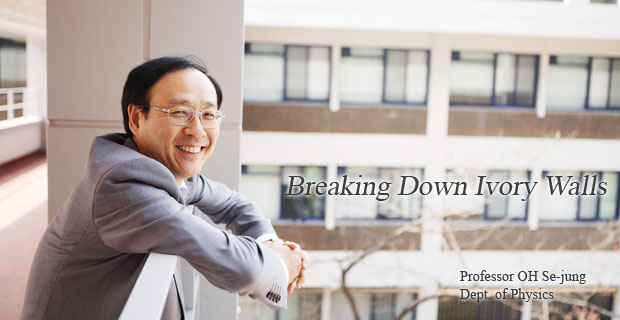
By Oh Se-jung, Professor of Physics
They say the 21st century is an age of fusion.
In his book “Consilience: The Unity of Knowledge,” Harvard University biologist Edward O. Wilson states that most problems we face, such as the environment or overpopulation, cannot be solved without unifying the humanities and social knowledge.
International futurist Alvin Toffler also criticized the over-specified contemporary knowledge system. In the book “Revolutionary Wealth,” written with his wife, Heidi, he says that imagination and creativity can only come from combining ideas, definitions and knowledge that were not related before in a new way.
In fact, the border between basic and applied research is gradually fading. It’s predicted that society will become a place where “mechanical engineers will have to observe bacteria and chemists will have to learn electrical engineering,” and dividing colleges of engineering and natural science will become insignificant. This was an idea put forward by Kim Kwang-woong, a professor emeritus at Seoul National University and an adviser to the Center for Public Leadership.
Universities of advanced countries are quickly counteracting this trend. In the United States, Stanford University started a Bio-X program around 10 years ago for joint life science studies between different educational systems. It operates a design research center where engineers, artists and scholars of social science and humanities gather for joint research.
The MIT Media Lab is considered the original place for fusion research. It already has a history of almost 25 years and is well known for its novel ideas and creative accomplishments. In Japan, the University of Tokyo created a new campus in Kashiwa City for cutting-edge research between educational systems, and operates many combined graduate school programs that cross over between science and liberal arts or social sciences.
Of course, many predict that traditional academic departments such as mathematics and physics will continue to exist despite the new trend. After all, even researchers who study different fields need to have a field of expertise, and traditional departments effectively train such experts.
However, universities in advanced countries have many policies to encourage professors of traditional departments to conduct fusion education and studies. Major examples are appointing one professor to work in multiple positions in different departments, or at a collaborative research center.
Most professors with these policies are thus affiliated with many different research centers or departments, and students freely study different majors and conduct collaborative research.
How are Korean universities, then, keeping up with this international trend? Unfortunately, the answer is very negative. Fusion educational and research facilities have started to appear in Korea, such as the Seoul National University Combined Graduate School of Science and Technology, but there appears to be a limit to the extent to which academics can collaborate here.
First of all, the education system is too rigid. Regulations state that a university professor can only be affiliated with one department. Therefore, there is no way professors can work in different departments and conduct collaborative education and research like in foreign universities.
Furthermore, professors don’t appear motivated to break out of their field of study and the walls between departments appear high. The closed atmosphere forces professors to be more interested in maintaining their field and vested interests, and how to divide the pie of knowledge rather than how to make it grow.
The more serious problem is that students are not inspired to take up challenges or be adventurous enough to take on unknown fields. But we need students to do just that. We need them to overcome borders in order to create internationally recognized accomplishments, but instead it is growing more and more difficult to produce human resources with such capabilities.
Korean universities must quickly break away from their closed attitudes to become top-notch schools with better reach and vision.
Hwang Chang-gyu, who serves as the chief technology officer at Samsung Electronics, said Samsung was able to catch up with Sony because of the change from analog to digital. In other words, when a paradigm changes it’s a great time to beat the former No. 1.
With the academic paradigm changing from traditional areas to a fusion between different educational systems, now is the time for Korean universities to catch up to and advance beyond universities in other countries.
Our universities must not lose the opportunity to become the world’s best, and breaking down the walls between departments is an urgent priority toward reaching this goal.

